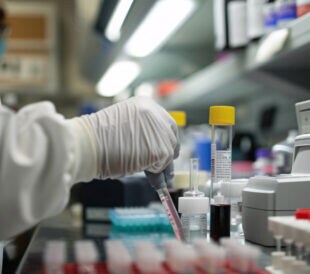Ion chromatography (IC) is a powerful analytical technique with applications across all scientific endeavors. However, this flexibility comes with the necessity of dealing with a huge variety of sample types and its effectiveness hinges on proper sample preparation. Sample preparation techniques and processes can impact analysis quality, efficiency, and cost.
In this blog post, we’ll explore the critical role of sample preparation in IC and how automation can increase analytical precision and reduce costs. Whether you’re analyzing trace contaminants in ultrapure water or processing high-throughput environmental samples, placing attention and investment on how you prepare your samples will likely provide the best return to your lab’s capabilities.

The sample preparation challenge in IC
When running IC analyses, each sample may require specific preparation steps to ensure accurate and reliable results:
- Filtration: Removing particulates to protect system components and ensure consistent results.
- Dilution: Adjusting sample concentration to fall within the linear range of the detector.
- Matrix elimination: Removing interfering ions or compounds that could mask analytes of interest.
- Preconcentration: Concentrating dilute samples to improve detection limits.
- pH adjustment: Ensuring sample compatibility with the column and detection method.
While manual sample preparation has been the traditional approach, it comes with several inherent challenges. These issues can significantly impact the efficiency and reliability of IC analyses:
- Time-consuming: Each step requires hands-on time from skilled analysts.
- Inconsistency: Variation between analysts can lead to inconsistent results.
- Contamination risk: Each manual handling step introduces potential for contamination.
- Human error: Mistakes in dilution calculations or labeling can compromise entire batches.
- Limited throughput: Manual preparation becomes a bottleneck for high-volume laboratories.
The challenges of manual sample preparation extend beyond the immediate workflow, affecting overall laboratory performance and the quality of analytical results. Understanding these impacts is crucial for laboratories looking to optimize their IC processes:
- Data quality: Inconsistencies in preparation can lead to poor analytical reproducibility and accuracy.
- Turnaround time: Manual preparation extends analysis time, delaying results for stakeholders.
- Cost: Skilled analyst time spent on repetitive tasks increases per-sample costs.
- Sample integrity: Delays between preparation and analysis can lead to sample degradation.
- Method transfer: Manual methods are harder to standardize across different labs or locations.
Addressing these sample preparation challenges is crucial for laboratories seeking to improve their IC workflow, enhance data quality, and optimize resource utilization. In the following sections, we’ll explore how automation can tackle these issues head-on, transforming the IC analytical process.
Thermo Scientific’s IC sample preparation portfolio
Thermo Scientific offers a comprehensive range of ion chromatography systems designed to meet diverse laboratory needs, with each model incorporating varying degrees of automated sample preparation capabilities. Since the Dionex ICS-6000 offers the most comprehensive suite of features, along with the unrestricted ability to combine them into a single workflow, we will focus solely on what is possible with this system. Other Thermo Scientific Dionex instruments also incorporate automated sample preparation features, though to varying extents.
| Technique | Features |
| Filtration | In-line AS-DV Autosampler filters In-line Filter Frit cartridges |
| Dilution | AutoDilution with AS-AP and Chromeleon CDS |
| Matrix elimination | InGuard cartridges IonPac NG-1 Columns Continuously Regenerated Trap Columns AutoNeutralization |
| Preconcentration | Electrolytic Water Purifiers AutoPrep Anion, Cation, and Transition metal concentrator columns |
| Specialty | Combustion IC Air sampling |
Filtration:
The ICS-6000 offers two automated filtration options: in-line AS-DV Autosampler filters and in-line Filter Frit cartridges.
The AS-DV Autosampler filters are 20 μm filtering devices that sit atop the sample in either 5 mL or 0.5 mL sample vials. They provide automatic, high-capacity removal of particulates prior to injection. A key advantage is that particulates settle to the bottom of the vial, so the least contaminated sample is filtered first, preventing clogging and enhancing the filter’s capacity. Individual filters are used for each sample, eliminating carryover concerns.
In-line Filter Frit cartridges are made of PEEK to prevent ion contamination and have a minimal dead volume. They can be used in various in-line locations and are compatible with the modern, higher backpressure, Reagent-Free systems.
Both options automate the crucial step of removing particulates from samples, protecting system components and ensuring consistent results. This automation reduces the risk of contamination, saves analyst time, and improves reproducibility.
Dilution:
AutoDilution requires the Dionex AS-AP and Chromeleon CDS to automate the process of adjusting sample concentrations. This feature can detect target analytes that are out of calibration ranges, automatically dilute them, and reinject for analysis. Decisions to dilute and reinject can be based on a single parameter such as peak area, height, amount, resolution, or other chromatographic value, or on a combination of values.
The system can use different sized sample loops to achieve the required dilution. For example, it might first inject using a large loop, and if the sample is too concentrated, it will automatically switch to a smaller loop, dilute the sample, and reinject.
This automation eliminates manual dilution errors, improves precision, and significantly reduces analyst time. It’s particularly beneficial for samples with varying concentration levels, as it can handle a wide range of concentrations without user intervention.
Matrix elimination:
The ICS-6000 offers multiple automated matrix elimination options:
- InGuard Cartridges provide high-throughput automated removal of matrix interferences. They can be placed in either low-pressure (autosampler) or high-pressure (pump) locations. Available chemistries include Silver (Ag) for halides, Hydrogen (H) for cations and pH adjustment, Sodium (Na) for magnesium, calcium, and transition metals , hydrophilic reversed phase (HRP) for hydrophobic species, and Na/HRP for metals plus organics.
- IonPac NG-1 Columns are packed with highly hydrophobic cross-linked polystyrene resin beads for the removal of organic contaminants from samples, such as humic acids. A two-column setup with a 10-port valve enables automatic resin cleaning of one trap column while the other is being used for sample preparation.
- Continuously Regenerated Trap Columns (CR-TC) provide continuously regenerated sample purification devices for maintenance-free operation. Both anion removal (CR-ATC) and cation removal (CR-CTC II) devices are available.
- For trace analysis in concentrated acids and bases, AutoNeutralization utilizes high-capacity electrolytic suppressors (e.g. Dionex ADRS or CDRS 4mm) to neutralize samples prior to injection, coupled with a concentrator column to collect and focus the remaining trace ions.
Preconcentration:
Automated preconcentration is achieved through several methods:
- Electrolytic Water Purifiers (EWPs) produce low flow rate streams of exceptionally pure water. These water streams can be used to displace water for loading samples onto concentrator columns. Additional electrolytic power supplies, such as those found in the ICS-6000 Automation Manager, are required.
- AutoPrep utilizes RFIC-ESP (Reagent-Free Ion Chromatography – Electrolytic Sample Preparation) techniques that simplify the analysis of trace levels of anions or cations. It uses EWPs to transfer large sample volumes to the concentrator column, virtually eliminating background contamination and allowing for low ng/L concentrations of ions to be conveniently analyzed. Combinations of additional electrolytic power supplies and auxiliary valves are required, which can only be supported by the ICS-6000 system.
- Various Concentrator Columns are available for anions, cations, and transition metals. These columns retain ions from a measured volume of aqueous sample matrix, thereby concentrating the analyte species and lowering detection limits. They enable the analysis of ions at μg/L (ppb) to ng/L (ppt) levels.
These features allow for the automated concentration of dilute samples, significantly improving detection limits without manual intervention. This automation not only saves time but also enhances reproducibility and enables the analysis of trace-level analytes.
Automated IC sample prep for significant returns
Investing in automated sample preparation capabilities can yield significant returns in terms of data quality, laboratory efficiency, and overall analytical capabilities. For laboratories looking to optimize their IC workflows, enhance their data quality, or push the boundaries of their analytical capabilities, embracing automated sample preparation technologies is a necessity.
Due to the high levels of customization possible to your particular sample requirements, I highly recommend speaking with our expert field sales and service professionals for their insight. However, the Thermo Scientific Dionex ICS-6000, with its comprehensive suite of automated sample preparation features, is the ideal platform for you to explore the possibilities.
Related information
Product specifications: PS70526 – Thermo Scientific concentrator and trap columns
Product manual: OnGuard II Cartridges – Product Manual (Revision 10)
Product manual: InGuard Cartridges
Visit our LinkedIn page #IonChromatography #IC #SamplePreparation



